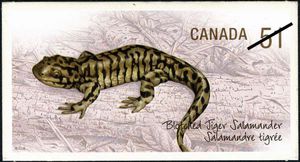Pathogenic diseases and environmental contaminants are two of the leading
hypotheses for global amphibian declines, yet few studies have examined the influence of contaminants on disease susceptibility. In this study, we examined effects of ecologically relevant doses of atrazine (0, 1.6, 16, and 160 ug/L), sodium nitrate (0, 6.8, 68 mg/L), and their interactions on susceptibility of four laboratory-bred tiger salamander families to Ambystoma tigrinum virus (ATV), a pathogen implicated in global amphibian die-offs.
Salamanders were from Arizona populations where a coevolutionary history with ATV is supported, and thus cofactors rather than recent introduction may contribute to disease epizootics. Use of atrazine and nitrogenous fertilizers are ubiquitous; therefore, the impact of these cofactors on disease susceptibility is an important consideration. Atrazine and sodium nitrate significantly decreased peripheral leukocyte levels, suggesting an impact of these contaminants on the immune system. As expected from this result, atrazine significantly increased susceptibility of larvae to ATV infection. In contrast, nitrate had a marginally significant main effect and significantly decreased infection rate at the highest level. However, neither atrazine nor sodium nitrate had significant effects on viral copy number per individual. These results suggest that ecologically relevant concentrations of atrazine and nitrates have immunosuppressive effects, and atrazine may contribute to ATV epizootics, raising concerns about the influence of contaminants on diseases in general.
Source:
D. D. FORSON AND A. STORFER. Ecological Applications, 16(6), 2006, pp. 2325–2332 (attached)

- Login om te reageren
